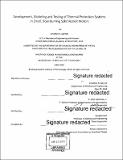| dc.contributor.advisor | R. John Hansman, Jr. and Douglas Hart. | en_US |
| dc.contributor.author | Spirnak, Jonathan R | en_US |
| dc.contributor.other | Massachusetts Institute of Technology. Department of Mechanical Engineering. | en_US |
| dc.date.accessioned | 2018-10-22T18:45:01Z | |
| dc.date.available | 2018-10-22T18:45:01Z | |
| dc.date.copyright | 2018 | en_US |
| dc.date.issued | 2018 | en_US |
| dc.identifier.uri | http://hdl.handle.net/1721.1/118689 | |
| dc.description | Thesis: S.M., Massachusetts Institute of Technology, Department of Mechanical Engineering, 2018. | en_US |
| dc.description | Cataloged from PDF version of thesis. | en_US |
| dc.description | Includes bibliographical references (pages 59-60). | en_US |
| dc.description.abstract | Currently, a void exists in the development of small, unmanned aerial vehicles (UAVs) that can fly at speeds faster than 100 meters per second while maximizing endurance. Operating in such a regime requires the use of a slow-burning solid rocket motor. To achieve long burn times, an end-burning grain configuration is required in addition to a burn rate suppressant. Such a propulsion system presents unique thermal challenges due to the long exposure times and the close proximity of temperature sensitive vehicle components to the combustion reactions. This thesis presents the development of a thermal management system appropriate for small, slow burning solid rocket motors. Thermal protection is provided primarily by a thermally ablative liner with additional layers of fibrous insulation to protect the motor casing and avionics. Due to the complex nature of thermochemical ablation and scarcity of previous research in slow, end burning solid rockets, this problem is approached through both experimental and computational means. Experimental tests are performed on a full-scale model of an end-burning motor. Experimental results are used to validate a computational model of ablation. The ultimate goal is to provide an adequate amount of thermal insulation to protect the vehicle casing and avionics while maximizing propellant volume and hence endurance. Building such thermal management schemes requires innovative materials and machining methods to incorporate thermal protection in a tight space. This thesis adds to the greater body of knowledge of thermal protection design in slow-burning solid rockets, especially as it applies to a new class of small, fast UAVs. | en_US |
| dc.description.statementofresponsibility | by Jonathan R. Spirnak. | en_US |
| dc.format.extent | 84 pages | en_US |
| dc.language.iso | eng | en_US |
| dc.publisher | Massachusetts Institute of Technology | en_US |
| dc.rights | MIT theses are protected by copyright. They may be viewed, downloaded, or printed from this source but further reproduction or distribution in any format is prohibited without written permission. | en_US |
| dc.rights.uri | http://dspace.mit.edu/handle/1721.1/7582 | en_US |
| dc.subject | Mechanical Engineering. | en_US |
| dc.title | Development, modeling and testing of thermal protection systems in small, slow-burning solid rocket motors | en_US |
| dc.type | Thesis | en_US |
| dc.description.degree | S.M. | en_US |
| dc.contributor.department | Massachusetts Institute of Technology. Department of Mechanical Engineering | |
| dc.identifier.oclc | 1056953431 | en_US |
